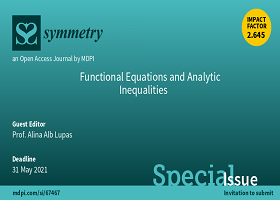Functional Equations and Analytic Inequalities
A special issue of Symmetry (ISSN 2073-8994). This special issue belongs to the section "Mathematics".
Deadline for manuscript submissions: closed (31 May 2021) | Viewed by 37231

Special Issue Editor
Interests: topological algebra; geometric function theory; inequalities
Special Issues, Collections and Topics in MDPI journals
Special Issue Information
Dear Colleagues,
The field of functional equations is an ever-growing branch of mathematics with far-reaching applications; it is increasingly used to investigate problems in mathematical analysis, combinatorics, biology, information theory, statistics, physics, the behavioral sciences, and engineering.
Inequalities play a significant role in all fields of mathematics and present a very active and attractive field of research.
This Special Issue promotes an exchange of ideas between eminent mathematicians from many parts of the world, dedicated to the Functional Equations and Analytic Inequalities. It is intended to boost cooperation among mathematicians working on a broad variety of pure and applied mathematical areas.
This volume of ideas and mathematical methods will include a wide area of applications in which the equations, inequalities, and computational techniques relevant to their solutions play an important role. These ideas and methods have a significant effect on everyday life, as new tools have been developed and achieved revolutionary research results, bringing scientists even closer to exact sciences, encouraging the emergence of new approaches, techniques, and perspectives in functional equations, analytical inequalities, etc. Please note that all submitted papers should be within the scope of the journal.
Prof. Alina Alb Lupas
Guest Editor
Manuscript Submission Information
Manuscripts should be submitted online at www.mdpi.com by registering and logging in to this website. Once you are registered, click here to go to the submission form. Manuscripts can be submitted until the deadline. All submissions that pass pre-check are peer-reviewed. Accepted papers will be published continuously in the journal (as soon as accepted) and will be listed together on the special issue website. Research articles, review articles as well as short communications are invited. For planned papers, a title and short abstract (about 100 words) can be sent to the Editorial Office for announcement on this website.
Submitted manuscripts should not have been published previously, nor be under consideration for publication elsewhere (except conference proceedings papers). All manuscripts are thoroughly refereed through a single-blind peer-review process. A guide for authors and other relevant information for submission of manuscripts is available on the Instructions for Authors page. Symmetry is an international peer-reviewed open access monthly journal published by MDPI.
Please visit the Instructions for Authors page before submitting a manuscript. The Article Processing Charge (APC) for publication in this open access journal is 2400 CHF (Swiss Francs). Submitted papers should be well formatted and use good English. Authors may use MDPI's English editing service prior to publication or during author revisions.
Keywords
- Functional equations in several variables
- difference equations
- stability problems
- set-valued functional equations
- iterative functional equations and iteration theory
- chaos
- dynamical systems
- iterative roots
- iteration groups and semigroups
- functional inequalities
- convexity
- inclusions for multivalued functions
- differential and difference inequalities
- means
- applications in ODEs
- PDEs
- functional analysis
- operator theory
- approximation theory
- number theory
- actuarial mathematics
- social sciences and others
Benefits of Publishing in a Special Issue
- Ease of navigation: Grouping papers by topic helps scholars navigate broad scope journals more efficiently.
- Greater discoverability: Special Issues support the reach and impact of scientific research. Articles in Special Issues are more discoverable and cited more frequently.
- Expansion of research network: Special Issues facilitate connections among authors, fostering scientific collaborations.
- External promotion: Articles in Special Issues are often promoted through the journal's social media, increasing their visibility.
- e-Book format: Special Issues with more than 10 articles can be published as dedicated e-books, ensuring wide and rapid dissemination.
Further information on MDPI's Special Issue policies can be found here.





